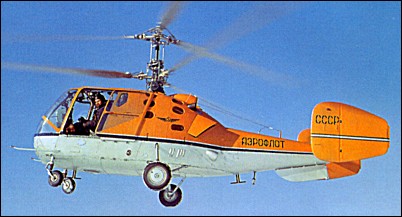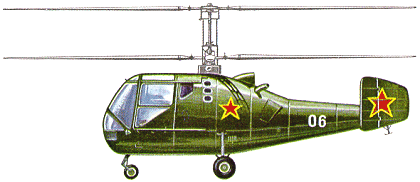
| Kamov Ka-15 1998 |  |
 |

| Kamov Ka-15 1998 |  |
 |
|
In 1950 AV-MF wrote outline requirement for larger two-seat helicopter with enclosed cabin and much greater endurance. Rotor hubs and blades scaled up but compared with Ka-10M, only significant change was low-density foam filling of blades between ribs and taper of blades towards tip. Basis of airframe welded steel tube, with covering of ply or dural removable panels and thin plastics glazing and sliding side doors round side-by-side cockpit ahead of rotor, with engine behind. Latter mounted with crankshaft horizontal, driving cooling fan, 90� angle drive to rotor via over-running clutch, and DC generator starter. From engine to tail, stressed-skin dural construction, with fixed tail comprising braced tailplane and two endplate fins toed in at front (parallel on some Ka-15s), with pedal-driven rudders for yaw control (poor in hover). First flight by V.V.Vinitskii early 1952. Rather slow development, but probably in production 1955 and subsequently some hundreds built in several versions. Most fitted with two main and two nose landing wheels, plus tail bumper; nose wheels castoring and main wheels braked. At least one with pontoons and one with three skis. AV-MF used substantial number for liaison, ship-based recon and dual Uka-15 for training. Ship trials 1954 including dripping sonar, but unable to carry equipment needed for ASW mission. From 1958 civil Ka-15M used for many roles including ag-spraying; Ka-15S equipped to carry two external stretchers. Set records, best (5 May 1959) 170.455km/h over 500km. Small number exported. ASCC reporting name "Hen". Bill Gunston "The Osprey's Encyclopedia of Russian Aircraft", 2000
Shipboard operations with the Ka-10 showed the necessity to start the construction of a new rotary-wing machine capable of lifting greater loads and less restricted by weather conditions. It was to have an enclosed cockpit fitted with the necessary equipment and providing normal conditions for the pilot, allowing him to function properly. These requirements were met by the Ka-15 which, like its predecessors, featured the co-axial layout. It was a two-seat helicopter with side-by-side seating for the pilot and a mission equipment operator or a passenger. The Ka-15 made its first flight on April 14, 1953 at the hands of test pilot D.K.Yefremov. State acceptance trials were completed in 1955, and next year the helicopter entered production at aircraft factory No.99 in Ulan-Ude. The Ka-15 evolved into a number of specialized versions, including the multi-purpose Ka-15M, the UKa-15 dual-control trainer version and the four-seat Ka-18. In each case prototype construction began at factory No.82 in Tushino and was completed at the OKB's own experimental shop near Ukhtomskaya railway station. The leadership of the Soviet Navy ordered a fly-off between the Ka-15 co-axial helicopter and the Mil Mi-1 single-rotor helicopter, during which both types operated from the cruiser "Mikhail Kutuzov". By virtue of its small size and manoeuvrability the Ka-15 successfully performed take-offs from and landings on the ship's small helipad even in sea state 6 conditions. Conversely, the Mi-1 was considerably hampered by its long tail boom and tail rotor and could not operate when air turbulence and pitching and rolling motion of the ship were present. The results of the fly-off finally convinced the Navy that choosing the co-axial layout for a shipboard helicopter was the right decision. The ASW version the Ka-15 was fitted with two RGB-N sonobuoys or with the SPARU-55 automatic airborne receiver unit. One of such helicopters dropped sonobuoys in the designated part of a sea, the other received information from them about the presence or absence of a submarine. Once a submarine was detected, a third Ka-15 equipped with the OPB-1R sight and two 50-kg depth charges entered service. The first units equipped with Ka-15 helicopters were formed in 1957-58. In 1958 work commenced on equipping the destroyer "Svetly" (Project 57) with a helipad. In 1960-1961 the Navy took delivery of eight Project 57 ships featuring helipads, support equipment for helicopter operations and accommodation for pilots and maintenance personnel. The Ka-15 and its versions remained in service for almost 20 years. Between 1958 and 1963, rotor blades of new design were developed, tested and introduced on the Ka-15M and the Ka-18. They were made of composite materials which improved the lift/drag ratio of the rotor and extended the service life of the blades. In 1958-59 test pilot V.V.Vinitsky established two world speed records on the Ka-15M. In 1958 the Ka-18 was awarded a Gold Medal at the World Exhibition in Bruxelles. The Ka-15 marked the beginning of co-axial helicopters operations in the Navy and Civil aviation, the Soviet state airline. As was universally acknowledged, V.B.Barshevsky, M.A.Kupfer, N.N.Priorov, A.J.Vlasenko and D.K.Yefremov made major contribution to the development of the Ka-15. G.Kuznetsov "OKB Kamov - 50 years", 1999
On the basis of past experience, whilst developing the Ka-10 "flying motorcycle", the design team also built a two-seat helicopter with an enclosed cabin and the same arrangements of coaxial, contra-rotating rotors and endplate fin tail unit, to meet a Soviet Naval Air Force specification. The new helicopter, designated Ka-15, flew towards the end of 1952 and went into production for the Soviet Navy and for civil operation as the Ka-15M. For military use, it could carry two depth charges on rails at the sides of the fuselage, which in the civil version were replaced by two stretchers or hoppers for agricultural chemicals. The powerplant was a 225hp AI-14V air-cooled radial engine installed at the center of the fuselage, but towards the end of 1960, most Ka-15Ms were given uprated 275hp AI-14VF engines. The NATO reporting name for the Ka-15 is Hen. G.Apostolo "The Illustrated Encyclopedia of Helicopters", 1984 
|